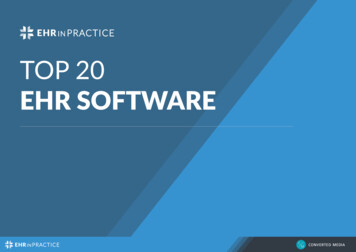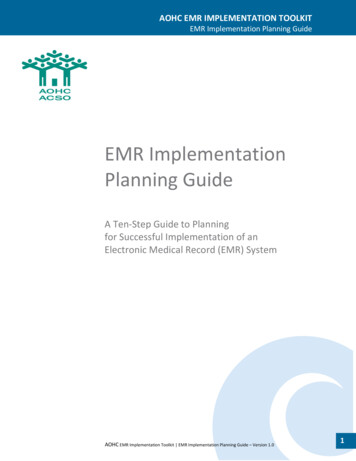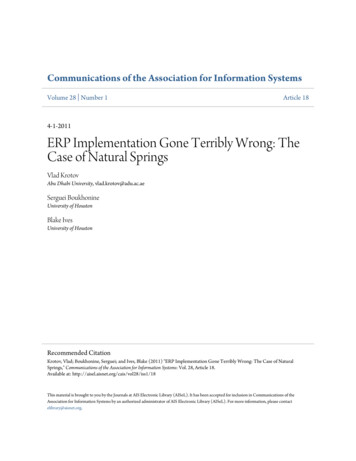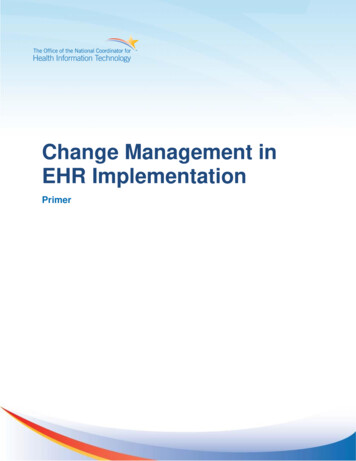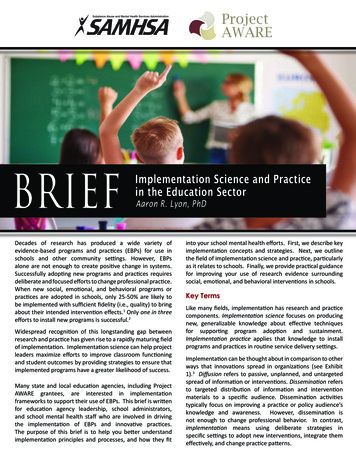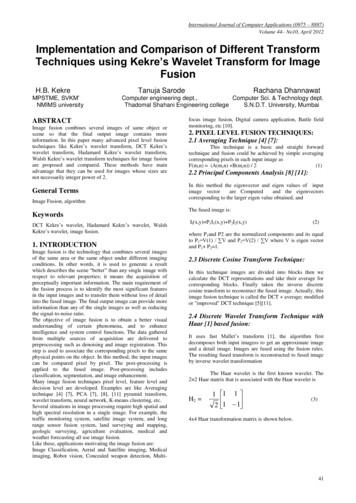
Transcription
International Journal of Computer Applications (0975 – 8887)Volume 44– No10, April 2012Implementation and Comparison of Different TransformTechniques using Kekre’s Wavelet Transform for ImageFusionH.B. KekreMPSTME, SVKM’NMIMS universityTanuja SarodeRachana DhannawatComputer engineering dept.,Computer Sci. & Technology dept.Thadomal Shahani Engineering collegeS.N.D.T. University, MumbaiABSTRACTImage fusion combines several images of same object orscene so that the final output image contains moreinformation. In this paper many advanced pixel level fusiontechniques like Kekre’s wavelet transform, DCT Kekre’swavelet transform, Hadamard Kekre’s wavelet transform,Walsh Kekre’s wavelet transform techniques for image fusionare proposed and compared. These methods have mainadvantage that they can be used for images whose sizes arenot necessarily integer power of 2.General TermsImage Fusion, algorithmKeywordsDCT Kekre’s wavelet, Hadamard Kekre’s wavelet, WalshKekre’s wavelet, image fusion.1. INTRODUCTIONImage fusion is the technology that combines several imagesof the same area or the same object under different imagingconditions. In other words, it is used to generate a resultwhich describes the scene “better” than any single image withrespect to relevant properties; it means the acquisition ofperceptually important information. The main requirement ofthe fusion process is to identify the most significant featuresin the input images and to transfer them without loss of detailinto the fused image. The final output image can provide moreinformation than any of the single images as well as reducingthe signal-to-noise ratio.The objective of image fusion is to obtain a better visualunderstanding of certain phenomena, and to enhanceintelligence and system control functions. The data gatheredfrom multiple sources of acquisition are delivered topreprocessing such as denoising and image registration. Thisstep is used to associate the corresponding pixels to the samephysical points on the object. In this method, the input imagescan be compared pixel by pixel. The post-processing isapplied to the fused image. Post-processing includesclassification, segmentation, and image enhancement.Many image fusion techniques pixel level, feature level anddecision level are developed. Examples are like Averagingtechnique [4] [7], PCA [7], [8], [11] pyramid transform,wavelet transform, neural network, K-means clustering, etc.Several situations in image processing require high spatial andhigh spectral resolution in a single image. For example, thetraffic monitoring system, satellite image system, and longrange sensor fusion system, land surveying and mapping,geologic surveying, agriculture evaluation, medical andweather forecasting all use image fusion.Like these, applications motivating the image fusion are:Image Classification, Aerial and Satellite imaging, Medicalimaging, Robot vision, Concealed weapon detection, Multi-focus image fusion, Digital camera application, Battle fieldmonitoring, etc [10].2. PIXEL LEVEL FUSION TECHNIQUES:2.1 Averaging Technique [4] [7]:This technique is a basic and straight forwardtechnique and fusion could be achieved by simple averagingcorresponding pixels in each input image asF(m,n) (A(m,n) B(m,n)) / 2(1)2.2 Principal Components Analysis [8] [11]:In this method the eigenvector and eigen values of inputimage vectorare Computedand the eigenvectorscorresponding to the larger eigen value obtained, andThe fused image is:If(x,y) P1I1(x,y) P2I2(x,y)(2)where P1and P2 are the normalized components and its equalto P1 V(1) / V and P2 V(2) / V where V is eigen vectorand P1 P2 1.2.3 Discrete Cosine Transform Technique:In this technique images are divided into blocks then wecalculate the DCT representations and take their average forcorresponding blocks. Finally taken the inverse discretecosine transform to reconstruct the fused image. Actually, thisimage fusion technique is called the DCT average; modifiedor "improved" DCT technique [5][11].2.4 Discrete Wavelet Transform Technique withHaar [1] based fusion:It uses fast Mallet’s transform [1], the algorithm firstdecomposes both input imagess to get an approximate imageand a detail image. Images are fused using the fusion rules.The resulting fused transform is reconstructed to fused imageby inverse wavelet transformationThe Haar wavelet is the first known wavelet. The2 2 Haar matrix that is associated with the Haar wavelet isH2 1 1 1 2 1 1 (3)4x4 Haar transformation matrix is shown below.41
International Journal of Computer Applications (0975 – 8887)Volume 44– No10, April 2012 1 H4 4 11111120 20021 1 0 2 (4)3. KEKRE’S TRANSFORM [6] [9]:Figure 2 shows MxM Kekre’s Wavelet transform matrixgenerated from NxN Kekre’s transform matrix. First Nnumbers of rows of Kekre’s Wavelet transform matrix aregenerated by repeating every column of Kekre’s transformmatrix P times. To generate remaining (M-N) rows, extractlast (P-1) rows and last P columns from Kekre’s transformmatrix and store extracted elements in to temporary matrixsay T of size (P-1) x P . Figure 3 shows extracted elements ofKekre’s transform matrix stored in T.Kekre’s transform matrix can be of any size NxN, which neednot to be an integer power of 2. All upper diagonal anddiagonal elements of Kekre’s transform matrix are 1, whilethe lower diagonal part except the elements just belowdiagonal is zero. Generalized NxN Kekre’s transform matrixcan be given as shown in (5) . 111 . N 111 .0- N 2 1 . .00.00.00.1 1 1 . . . 11 N ( N 1) 1 111.(5):x y: x y 1K12K13 K1(N-1)K1NK21K22K23 K2(N-1)K2NK31K32K33 K3(N-1)K3N. .KN1KN2KN3KN(N-1)KNN Figure 1 Kekre’s Transform (KT) matrix of size NxNThe formula for generating the element Kxy of Kekre’stransformmatrixis, 1 Kxy N ( x 1) 0 K11(6): x y 1Kekre’s Wavelet Transform [6] [9]:Kekre’s Wavelet transform is derived from Kekre’s transform.From NxN Kekre’s transform matrix, we can generateKekre’s Wavelet transform matrices of size (2N)x(2N),(3N)x(3N), , (N2)x(N2). For example, from 5x5 Kekre’stransform matrix, we can generate Kekre’s Wavelet transformmatrices of size 10x10, 15x15, 20x20 and 25x25. In generalMxM Kekre’s Wavelet transform matrix can be generatedfrom NxN Kekre’s transform matrix, such that M N * Pwhere P is any integer between 2 and N that is, 2 P N.Consider the Kekre’s transform matrix of size NxN shown inFigure 1.K(N-P 2) (N-P 1)K(N-P 2) (N-P 2) K(N-P 2) NK(N-P 3) (N-P 1)K(N-P 3) (N-P 2) K(N-P 3) N. .KN (N-P 1)KN (N-P 2) KNNFigure 3 Temporary matrix T of size (P-1) x PIn the same way DCT kekre's wavelet Technique, Hadamardkekre's wavelet Technique and Walsh kekre's waveletTechnique are implemented. In these techniques instead ofusing Kekre’s transform matrix as base matrix the respectivetransform matrices are used as base matrices and then waveletmatrix is generated by the above illustrated technique42
International Journal of Computer Applications (0975 – 8887)Volume 44– No10, April 20122nd column of kekre’sNth column of kekre’s transformtransform repeated P timesrepeated P times1st column of kekre’s transformrepeated P timesK11K11 K11K12K12 K12 K1NK1N K1NK21K21 K21K22K22 K22 K2NK2N K2NK31K31 K31K32K32 K32 K3NK3N K3N . KN1KN1 KN1KN2KN2 KN2 KNNKNN KNNK(N-P 2)K(N-P 2) K(N-P 2) N00 0 00 0(N-P 1)(N-P 2)00 0K(N-P 2)K(N-P 2) K(N-P 2) 00 0(N-P 1)(N-P 2)K(N-P 2) (N-K(N-P 2) K(N-P 2) NP 1)(N-P 2) 00K(N-P 3)K(N-P 3)(N-P 1)(N-P 2)00 N 000 0 K(N-P 3) N00 0 00 0 0K(N-P 3)K(N-P 3) K(N-P 3) 00 0(N-P 1)(N-P 2)K(N-P 3) (N-K(N-P 3) K(N-P 3) NP 1)(N-P 2)N 0KN (N-0 000 0 KN (N-P 2) KNN00 0 00 00 0KN (N-P 1)KN (N-P 2) K NN 00 0KN (N-P 1)KN) (N-P 2) KN NP 1)0 00 000 0Figure 2 Kekre’s Wavelet transform matrix of size MxM generated from Kekre’s transform matrix of size NxN.Where M N* P, 2 P N.4. PPOPOSED ALGORITHMAveraging and PCA methods are applied on 9 set of images asdescribed and for all other transform techniques algorithm isgiven as follows:1.2.Take as input two images of same size and of sameobject or scene taken from two different sensors likevisible and infra red images or two images havingdifferent focus.If images are colored separate their RGB planes toperform 2D transforms.3.4.5.6.7.Perform decomposition of images using differentnew transforms like Kekre’s Wavelet transform,DCT Kekre’sWavelet transform, HadamardKekre’s Wavelet transform and Walsh Kekre’sWavelet transform etc.Fuse two image components by taking average [2].Resulting fused transform components areconverted to image using inverse transform.For colored images combine their separated RGBplanes.Compare results of different methods of imagefusion using various measures like entropy, standarddeviation, mean, mutual information, etc.43
International Journal of Computer Applications (0975 – 8887)Volume 44– No10, April 20125. RESULTS AND ANALYSISAbove mentioned techniques are tried on pair of three RGBimages and six gray images as shown in fig. 4 and results arecompared based on measures like entropy, mean, standarddeviation and mutual information [3] [11].Figure 5 showsImage fusion by different techniques for visible and infra redscenery images. Figure 6 shows Image fusion by differenttechniques for hill images with different focus. Figure 7shows Image fusion by different techniques for gray clockimages with different focus. Performance evaluation based onabove mentioned four measures for color image is given intable 1. Table 2 presents performance evaluation for grayimages.Visible and Infra red Scenery imagesBrain ImagesClock ImagesBook ImagesMedical ImagesHill images with different focusMRI ImagesVisible and Infra red gray imagesCT and MRI imagesFigure 4 Sample images44
International Journal of Computer Applications (0975 – 8887)Volume 44– No10, April 2012a) visible light Inputimage1b) infrared light Inputimage2c)Averaging fused imaged)DCT fused imagee)PCA fused imagef)Haar wavelet fusedimageg)Kekre’s wavelet fusedimageh)DCT Kekre’s waveletfused imagei)Hadamard Kekre’swavelet fused imagej)Walsh Kekre’s waveletfused imageFigure 5 Image fusion by different techniques visible and infra red imagesa) Input image1b) Input image2c)Averaging fused imaged)DCT fused imagee)PCA fused imagef)Haar wavelet fusedimageg)Kekre’s wavelet fusedimageh)DCT Kekre’s waveletfused imagei)Hadamard Kekre’swavelet fused imagej)Walsh Kekre’s waveletfused imageFigure 6 Image fusion by different techniques for hill images with different focusa) Input image1b) Input image2c)Averaging fused imaged)DCT fused imagee)PCA fused image45
International Journal of Computer Applications (0975 – 8887)Volume 44– No10, April 2012f)Haar wavelet fusedimageg)Kekre’s wavelet fusedimageh)DCT Kekre’s waveletfused imagei)Hadamard Kekre’swavelet e fused imagej)Walsh Kekre’s waveletfused imageFigure 7 Image fusion by different techniques images with different focusTable 1 Performance evaluation for color 57.48030.51370.5137Table 2 Performance evaluation for gray 43160.51850.52020.49540.51820.51480.52060.520646
International Journal of Computer Applications (0975 – 8887)Volume 44– No10, April 2012CT MRIimagesMedicalimagesBrainimagesMRIimagesVisible& infrared 770.20460.20040.19870.1987From table 1 it is observed that for hill and book images meanindicating brightness is maximum for Hadamard Kekre’swavelet and Walsh Kekre’s wavelet technique, while forscenery images it is maximum for PCA. And standarddeviation gives clarity and contrast is maximum using DCTKekre’s wavelet technique for hill images, while for bookimages Haar wavelet technique and for scenery images PCAgives best results. Entropy indicating amount of information iscarried by the fused image is maximum using Haar wavelettechnique for hill and scenery images, while for book imagesHadamard Kekre’s wavelet and Walsh Kekre’s wavelettechnique gives best results. Mutual information is maximumby PCA technique for hill and scenery images meaning thatquality of fused image is better using this technique, while forbook images DCT-Kekre’s wavelet technique gives bestresults.and Walsh Kekre’s wavelet technique. Standard deviation andEntropy are maximum using Haar technique. For CT-MRIand MRI images PCA gives best results in terms of allmeasures. For medical images mean and MI are maximumusing PCA technique and SD and entropy are maximum usingHaar wavelet technique. For visible and infra red gray imagesmean, SD and MI are maximum using PCA technique whileentropy is maximum using Haar technique.In all these images if we observe the output of theKekre’s wavelet technique in different combinations it givesbest results for some images and for some images it is veryclose to the output and the major advantage of the matrix isthat it can be used for images which are not integral power of2.From table 2 it is observed that for clock and brain imagesmean and MI are maximum by Hadamard Kekre’s wavelet47
International Journal of Computer Applications (0975 – 8887)Volume 44– No10, April 20126. CONCLUSIONIn this paper many pixel level techniques like Kekre’s wavelettechnique and its combination with Kekre’s transform, DCT,Hadamard and Walsh are implemented and their results arecompared with basic techniques such as averaging, PCA,DCT, Haar wavelet. It is observed that the new Kekre’swavelet transform when used for image fusion givescomparatively good results, just closer to the best result andthe added advantage is that it can be used for images of anysize, not necessarily integer power of 2.7 REFERENCES[1] Nianlong Han; Jinxing Hu; Wei Zhang, “Multispectral and SAR images fusion via Mallat and À trouswavelet transform “,18th International Conference onGeoinformatics, 09 September 2010, page(s): 1 - 4[2] XING Su-xia, CHEN Tian-hua, LI Jing-xian “ImageFusion based on Regional Energy and StandardDeviation” , 2nd International Conference on SignalProcessing Systems (ICSPS), 2010,Page(s): 739 -743[3] Xing Su-xia, Guo Pei-yuan and Chen Tian-hua,” Studyon Optimal Wavelet Decomposition Level in Infraredand visual Light Image Fusion”, InternationalConference on Measuring Technology and MechatronicsAutomation (ICMTMA), 2010 , page(s): 616 – 619[4] Le Song, Yuchi Lin, Weichang Feng, Meirong Zhao “ANovel Automatic Weighted Image Fusion Algorithm”,International Workshop on Intelligent Systems andApplications, ISA ,2009 , Page(s): 1 – 4[5] MA. Mohamed and R.M EI-Den” Implementation ofImage Fusion Techniques for Multi-Focus Images UsingFPGA” 28th National Radio Science Conference (NRSC2011) April 26-28, 2011, Page(s): 1 – 11[6] Dr. H. B. Kekre, Archana Athawale, DipaliSadavarti,”Algorithm to Generate Kekre’s WaveletTransform from Kekre’s Transform” , InternationalJournal of Engineering Science and Technology,Vol.2(5), 2010, page(s): 756-767.[7] ation and Comparative Study of ImageFusion Algorithms”, International Journal of ComputerApplications, Volume 9– No.2, November 2010, page(s):25-35.[8] V.P.S. Naidu and J.R. Raol,” Pixel-level Image Fusionusing Wavelets and Principal Component Analysis”,Defence Science Journal, Vol. 58, No. 3, May 2008,Page(s): 338-352[9] Dr. H. B.Kekre, Dr. Tanuja K. Sarode, Sudeep Thepade,Sonal Shroff, “Instigation of Orthogonal WaveletTransforms using Walsh, Cosine, Hartley, KekreTransforms and their use in Image Compression”,(IJCSIS) International Journal of Computer Science andInformation Security, Vol. 9,No. 6, 2011, Page(s) 125133.[10] Zhang-Shu Xiao, Chong-Xun Zheng,”Medical ImageFusion Based on An Improved Wavelet nBioinfromatics and biomedical Engineering, 2009,Page(s)1-4.[11] H.B.Kekre, Tanuja Sarode, Rachana Dhannawat,”Kekre’s Wavelet Transform for Image Fusion andComparison with Other Pixel Based Image FusionTechniques”, vol. 10, No.3 March 2012.9. AUTHORS PROFILEH. B. Kekre: has received B.E. (Hons.) in Telecomm.Engineering. From Jabalpur University in 1958, M.Tech(Industrial Electronics) from IIT Bombay in 1960, M.S.Engg.(Electrical Engg.) from University of Ottawa in 1965 andPh.D. (System Identification) from IIT Bombay in 1970 Hehas worked as Faculty of Electrical Engg. and then HODComputer Science and Engg. at IIT Bombay. For 13 years hewas working as a professor and head in the Department ofComputer Engg. At Thadomal Shahani Engineering. College,Mumbai. Now he is Senior Professor at MPSTME, SVKM’sNMIMS. He has guided 17 Ph.Ds, more than 100M.E./M.Tech and several B.E./ B.Tech projects. His areas ofinterest are Digital Signal processing, Image Processing andComputer Networking. He has more than 270 papers inNational / International Conferences and Journals to hiscredit. He was Senior Member of IEEE. Presently He isFellow of IETE and Life Member of ISTE Recently 11students working under his guidance have received best paperawards. Two of his students have been awarded Ph. D. fromNMIMS University. Currently he is guiding ten Ph.D.students.Tanuja K. Sarode: has Received ch.(ComputerTechnology) from Mumbai University in 1999, M.E.(Computer Engineering) degree from Mumbai University in2004, Ph.D. from Mukesh Patel School of Technology,Management and Engineering, SVKM’s NMIMS University,Vile-Parle (W), Mumbai, INDIA. She has more than 12 yearsof experience in teaching. Currently working as AssistantProfessor in Dept. of Computer Engineering at ThadomalShahani Engineering College, Mumbai. She is life member ofIETE, member of International Association of Engineers(IAENG) and International Association of Computer Scienceand Information Technology (IACSIT), Singapore. Her areasof interest are Image Processing, Signal Processing andComputer Graphics. She has more than 100 papers in National/International Conferences/journal to her credit.Rachana Dhannawat: has received B.E. degree from SantGadg ebaba Amaravati University in 2003. She is pursuingM.E. from Mumbai University. She has more than 8years ofexperience in teaching. Currently working as assistantprofessor in Usha Mittal Institute of Technology, S.N.D.T.Univesity, Mumbai. She is life member of ISTE. Her area ofinterest are Image Processing,Networking, Computer graphicsand algorithms. She has one national and one internationaljournal paper to her credit.48
techniques like Kekre's wavelet transform, DCT Kekre's wavelet transform, Hadamard Kekre's wavelet transform, Walsh Kekre's wavelet transform techniques for image fusion are proposed and compared. These methods have main advantage that they can be used for images whose sizes are not necessarily integer power of 2. General Terms

